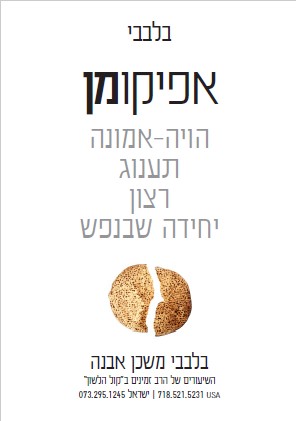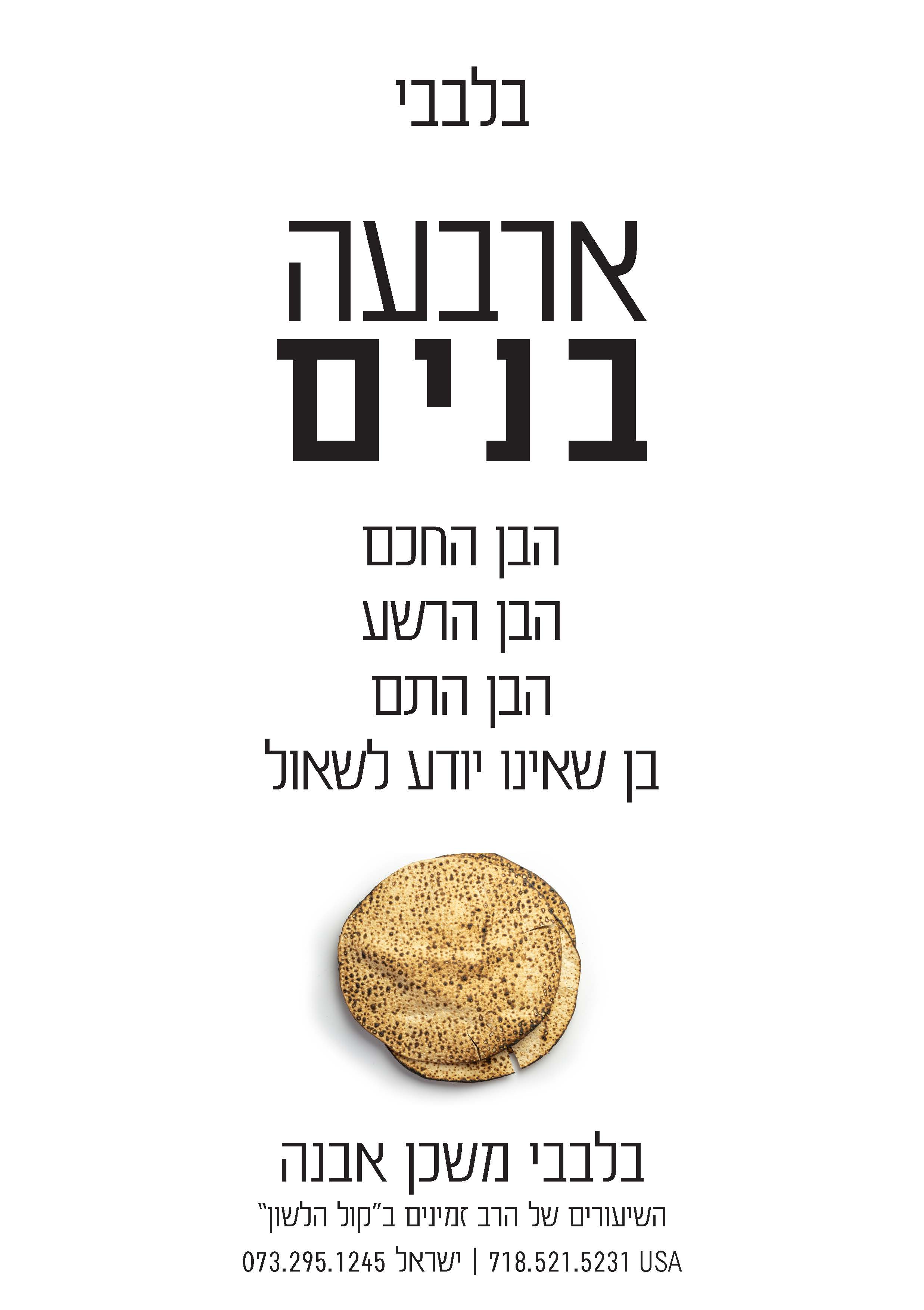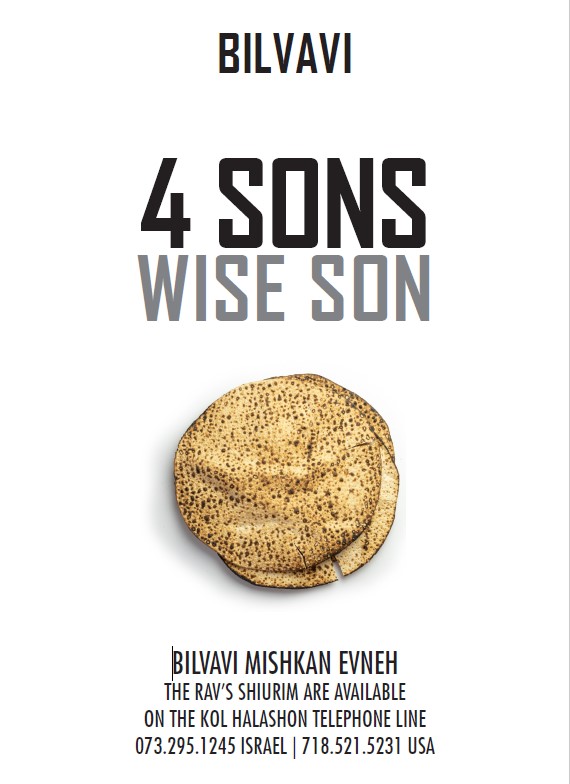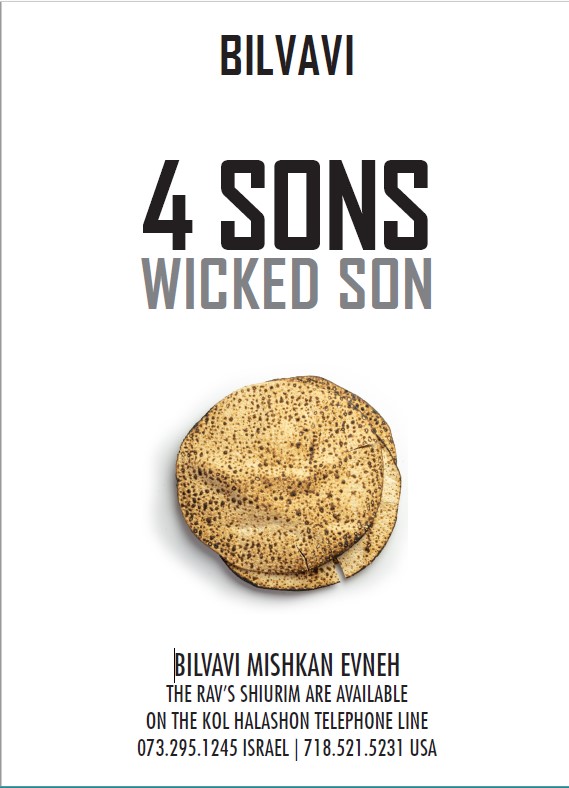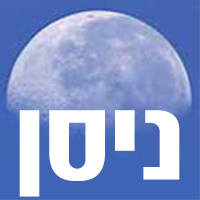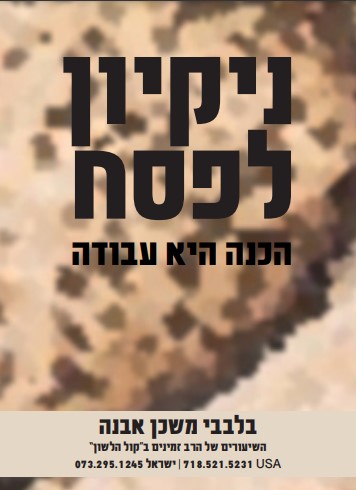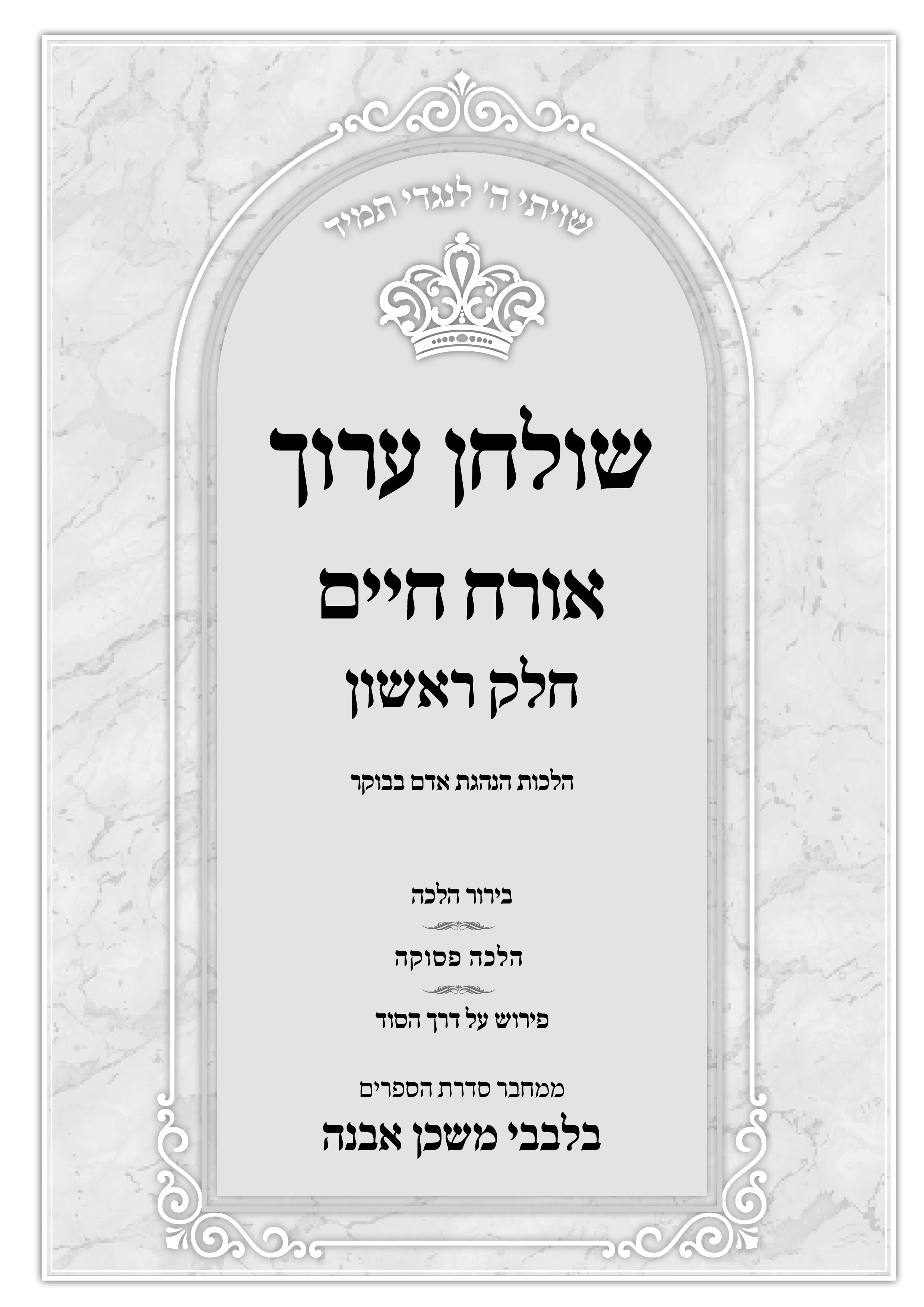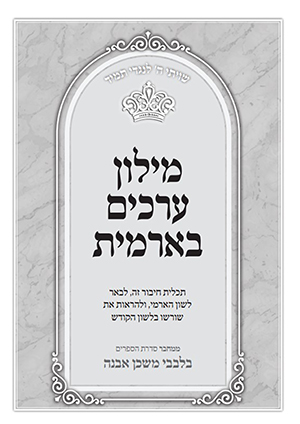- להאזנה Hisboddedus Practice 011 Summary of Ways To Access Your Neshama
011 Ways To Access Your Essence
- להאזנה Hisboddedus Practice 011 Summary of Ways To Access Your Neshama
Hisboddedus Practice - 011 Ways To Access Your Essence
- 5370 reads
- Printer-friendly version
- שלח דף במייל
Summary of the Previous Chapters
With the help of Hashem, we have merited to explain the depth of hisbodedus. We will first make a quick summary of what we learned until now before we proceed.
We have explained that physical seclusion is only the external part of hisbodedus. The essence of hisbodedus is to go deep into ourselves, to the place of “alone” in the soul where we can feel how we are one and alone with Hashem. When we reach our place of “alone” in the soul, we can talk to Hashem properly from there.
Until now, we explained how to reach inner calm, as a way to reach our soul. We mentioned the methods of using the senses to go deeper into our soul to attain inner quiet. Then we explained how to go deeper, through using our inner abilities of habatah, hakarah, and hakshavah to go deeper into our soul. These were all different ways of how we can reach our internal place in the soul of “alone”, in which we can feel utterly alone with Hashem.
We will now present, briefly, a few more ways of how we can reach our neshamah\soul, besides for the methods which we explained until now.
Method 1: Mesirus Nefesh To Perform A Particular Mitzvah
We have in us a power called maaseh\action. We use our power of action to perform the 613 mitzvos. The Rambam and others write that if a person connects himself deeply to one particular mitzvah he chooses, and he performs it with enthusiasm and with mesirus nefesh (to be self-sacrificing), he can reach the root of his soul. This is an amazing method that was practiced by our earlier sages in how to reach the soul. It uses our power to perform actions.
Our goal is always to reach our soul; there are many ways of how we reach our soul. This is one of the ways – by becoming devoted to a particular mitzvah. Take one mitzvah and decide that you will carry it out as complete as you can – be strict about how you perform it, and do it as perfectly as you can. Your joy, yearning and will should be present as you do the mitzvah. Take upon yourself that you will carry out this mitzvah no matter what comes your way, no matter what difficulties are getting in the way. By becoming devoted to one particular mitzvah you take upon yourself, it will connect you to the deepest place in yourself.
Which mitzvah should we choose? Any mitzvah can connect us to our soul, but each person has a certain mitzvah which will connect him more easily to his soul root. Choose a mitzvah that you feel more connected to, and take it upon yourself. Daven to Hashem and cry about this: that you should merit to discover the mitzvah which your soul is meant to mainly pursue.
This is an example of how you can “grab onto a particular detail and get everything through else it” (“getting the klal\general whole through the perat\details”): by holding onto one particular mitzvah and performing it with mesirus nefesh, we hold onto one detail and get through to our entire soul’s root, through it.
Method 2: Discovering Your Worst Middah
There is another way of how we can get through to our soul: by discovering your worst middah and uprooting it.
How do we discover our worst middah? As we have mentioned, Rav Chaim Vital writes that there are four elements in the soul, and these elements are the roots of our middos. They are: fire\conceit and anger; wind\idle speech, falsity, and flattery; water\desires and jealousy; and earth\sadness and laziness. Each person has a particular bad middah that is mainly dominant in his life.[1]
If you work to discover our own personal worst middah and we uproot it, you will get through to our neshamah. Be willing to have mesirus nefesh to uproot the bad middah.
As our Rabbis teach, each of us came down onto this world to fix a particular middah that we need to work on.[2] When we work on our middos, if we want to do this realistically, we can’t do it by working on a different middah every dayfor 40 days, or to work on a different middah for each of the 49 days of Sefiras HaOmer. Our inner avodah in tikkun hamiddos is to discover our worst middah, and to mainly work on uprooting our worst middah, and that will improve our other middos as a direct result. This takes a lot of time, but when achieved, we are able to reach our very soul.
In order to do it, a person needs to be able to have a bit of sensitivity to self-awareness – both intellectually, as well as emotionally, and to use his inner sensitivity to discover what his worst middah is. Most people, in fact, do not develop this inner awareness. A person must become sensitive to what his worst middah is, and this takes a lot of time, as well as lot of inner refinement. But if a person perseveres with this, with mesirus nefesh, he will be able to reach his very soul.
The second method, as we said, requires the ability of inner sensitivity. If someone doesn’t have the inner sense of awareness to his middos, using this method will not be feasible, so he should try the first method we mentioned.
Method 3: Persistent Torah Thought
Now we will present a third way to reach our soul. It is mostly applicable to men, but some women will be able to use it as well. It involves our power of thought (machshavah), which we mainly use to learn Torah.
The mitzvah of learning Torah applies only to men; women do not learn Torah, and Chazal discourage women from learning Torah in-depth. As Chazal say, “One who teaches Torah to his daughter has taught her foolishness.”[3] (Women only have to know the parts of Torah which apply to them.) Yet, this doesn’t mean that women do not have a power of deep thought. Besides for learning Torah, we need to develop our power of thought so we can absorb proper hashkafos (outlook) on life that are in line with the Torah, and this applies to both men and women alike.
So we need to use our power of thought to constantly think about important matters. Take a particular deep Torah thought, like a saying of Chazal, and keep thinking about it throughout the day. If you keep doing this, consistently, you will be able to get to your soul.
Method 4: Constant Mental\Verbal Repetition of Hashem’s Presence
There is also a fourth way of how you can reach your soul; but it is a very high level to practice, so it is not for most people to practice.
The Rambam and the Vilna Gaon both wrote that the possuk “Shivisi L’negdi Tamid” (“I place Hashem before me always”) contains every quality of tzaddikim (the righteous), and therefore a person should always think about it. Therefore, if a person keeps reviewing this special possuk, he has the power to reach his soul.
The review can be done either mentally or verbally. Men have an easier time doing this method, because they are used to mental review, whereas women have a hard time doing mental review; but what women can do is to constantly review this possuk verbally.
In any case, this method (constant mental\verbal repetition of a possuk) is a high level of avodah, and thus it is not for everyone to practice.
Summary of the Four Approaches of How To Reach Our Neshamah
We have mentioned here four general ways of how we can reach our soul: through doing a mitzvah with mesirus nefesh, through working on our worst middah, through constantly thinking about a certain Torah thought, or through constant mental\verbal review of “Shivisi”.
A Woman’s Challenge
These methods take a lot of time in our life, and they also take a lot of energy to work on. A married woman in particular is involved with her husband and children, and she has to somehow find how she can work on her Avodas Hashem together with all her roles in life. It takes a lot of wisdom how to balance her household role together with her avodah in reaching the soul.
We generally find two kinds of [frum] women in the world. One type of woman takes care of her house very well, exhausting all her efforts in life into taking care of her spouse and children, but, she never has time for developing her inner world; she has no time for any Avodas Hashem. By contrast, there are other women who are very spiritually-oriented and are thus very involved with developing their inner world, but they go extreme with their idealism, and they tend to ignore their home situation and neglect their responsibilities. Both of these lifestyles are extreme and they are not truthful ways of living.
What we need is the fine balance between our various responsibilities in life together with developing our inner world - and it indeed takes great wisdom to know how to balance out our roles in life.
Every Jewish woman should know, clearly, the following fundamental. We understand that a man’s main mitzvah is to learn Torah, yet we also know that this does not exempt him from keeping halacha, from davening with concentration, from working on his middos and from smiling at others, etc. In the same way, women, also have many responsibilities in life – their household, raising the children, maintaining their tzniyus (modesty), etc. but this is not all there is to a woman’s life. Although a woman’s main responsibilities are towards her household, this does not exempt her from working on her Avodas Hashem.
The Gemara tells us that there were 48 men prophets, and there were 7 women prophetesses.[4] We see from this that a woman can reach prophecy, the highest spiritual level possible, in spite of the fact that these seven women obviously had responsibilities in their life.
It is impossible to give exact guidance on how a woman can balance out her responsibilities and Avodas Hashem. If a woman is not sure on how she can do it, she can ask her husband or someone who can advise her on how to go about it.
In Conclusion
In the previous ten chapters, we described methods in how we can reach our inner self. In the next chapters, with Hashem’s help and assistance, we will discuss the next step in hisbodedus, which is to talk to Hashem, now that we have hopefully reached a deeper place in ourselves. The coming chapters, however, are based on this first step described in the previous chapters, which was how we connect to our inner self.
The matters discussed in the previous chapters are not so known to most people. The topic which we will discuss, b’ezras Hashem, in the future classes - talking to Hashem - is known to most people as a familiar part of hisbodedus, but, I will add on some subtle details that are not so well-known.
May we all merit to receive the light of the Torah, through the coming Yom Tov, completely.
QUESTIONS AND ANSWERS WITH THE RAV
Q1: In the previous class (#010: Inner Listening), the Rov spoke about accessing the “kol demamah dakah” (the “soft, silent voice”). What exactly is it?
A: Hashem created the world in ten expressions. When we all stood at Har Sinai, we heard the Ten Commandments, and the possuk says that there was a “great voice [of Hashem], which did not stop.” This voice continues until today. Chazal say that it is a Heavenly voice which goes out every day and bemoans the degradation of the Torah when it is neglected. We can all hear this Bas Kol, to a certain extent, if we reach into our soul. There are some tzaddikim reach a high level and can hear it on Shavuos, and they can hear it also during the rest of the year after that. But we are not speaking of how to reach this high level. Rather, we are describing of how we can hear the simple level of hearing spiritual kinds of sounds. Just like we understand that an animal can pick up on sounds, so can we learn how to pick up on spiritual sounds, when we deepen our sense of listening to become sensitive to the spiritual.
Q2: Is it a feeling or a thought?
A: It is heart matter, so it cannot be described in words. We can hear about it, conceptually, and thus draw ourselves closer to the matter, but it cannot be actually described in any way. It can be felt as a feeling or it can come to you as a thought, but we cannot actually describe it; you have to be there, and then you can understand it.
Q3: How do I know if I’m feeling it as a real feeling, or if I’m just imagining it?
A: When we hear something, what are we hearing? Are we just hearing the words, or are we hearing the details contained in the words? Sometimes even when we listen to a person talking to us, we aren’t really hearing them, and we are just imagining that we are hearing what he’s saying! So of course we can fool ourselves, both when it comes to physical listening, as well as when it comes to spiritual listening. It is very possible that we are just imagining it and fooling ourselves. We can be making mistakes with inner listening, but the more you develop it, the more you will be able to relate to it and come to really differentiate between a real feeling and something that’s only imagination.
Q4: Does our unique mitzvah have to be a Torah-level mitzvah, or can it be a mitzvah of Rabbinical nature?
A: It is more usual that our soul is connected to a Torah-level mitzvah, but it doesn’t have to be; it can be a Rabbinical mitzvah.
Q5: Can we use two methods at once of reaching our soul?
A: Each method takes massive inner work; it is not good to take on too much, so it is not recommended to work on more than one method at once.
Q6: I tried doing something enjoyable when I’m alone in order to get used to being alone, as the Rav said in the beginning of these classes to do [see class #02, Preparing To Be Alone] but it didn’t work for me. Should I keep trying to enjoy the quiet, or should I instead try one of the methods said here in this class?
A: The methods we discussed here are both easy and hard. Each person has a different method that works better, but it is still challenging to work on any of the methods. What we discussed earlier – calming our senses in order to attain quiet – is both easy and hard. Yet, as hard as it is, it doesn’t require mesirus nefesh on our part. But the methods we spoke about today have a different challenge: they are certainly more enjoyable than getting used to the quiet, but they are methods which require mesirus nefesh. So each of the methods (getting used to the quiet, or any of the methods described in today’s class) are each uniquely challenging.
Q7: If I write a diary when I’m alone, is that considered doing something I enjoy while being alone?
A: It’s a very good thing, but it should not be all that there is to your hisbodedus.
Q8: When we view ourselves from outside of ourselves, as described in the previous classes, can this also help us develop our power of hakshavah\inner listening, just like it helps us develop our power of habatah and hakarah?
A: It is definitely helpful. That is not all there is to it, but it can definitely be helpful to you.
Q9: Is there a sefer we can learn that helps us discover what our worst middah is?
A: There is no one sefer that explains how you can do it. Currently, we are giving classes on each of the bad middos; we have already given classes on Fixing Sadness and Fixing Laziness, and we are in the middle of Fixing Desires. The methods for fixing our middos are spread out throughout the sefarim, such as sefer Pele Yoetz; but they are not concentrated in any one sefer. [See link below].
Q10: I feel that I can do all of these three methods in this class all at once. Can I do it?
A: You will end up getting flustered from working on so much at once. Instead, take one of these methods and stick to it and focus on it.
Q11: When a person has self-doubts, from which element in the soul does it come from (earth, water, wind and fire)?
A: This is a very general question. What is the nature of the doubt? A doubt can be coming from any of the four elements. [Editor’s Note: See the new book Getting To Know Your Feelings, Chapter 6].
[1] See Getting To Know Your Soul to learn about the four elements in the soul and how to recognize which element is mainly dominant in your life.
[2] As taught by the Vilna Gaon [in sefer Even Shelaimah]
[3] Talmud Bavli: Sotah 20b
[4] Talmud Bavli: Megillah 14a. The seven prophetesses were: Sarah, Miriam, Channah, Devorah, Avigayil, Chuldah, and Esther.
NOTE: Final english versions are only found in the Rav's printed seforim »





